A sarcophagus discovered in 2009 in an Egyptian burial chamber came with a complicated history: ancient writing on the stone container indicated that it had been used twice, but although its second occupant, the 21st dynasty high priest Menkheperrê, the First owner remained a mystery…until now.
Frédéric Payraudeau, associate professor of Egyptology at Sorbonne University in Paris, has re-examined a fragment of the granite sarcophagus and deciphered the hieroglyphics engraved on it. Hidden in the cartouche, an oval-shaped ornament usually found in tombs, he found the name of a very recognizable character: Ramses II.
According to Payraudeau, the inscription is proof that the artifact originally came from the tomb of the famous pharaoh and had been reused after the looting.
“It’s clear it was the sarcophagus of a king,” Payraudeau said. “The cartouche dates back to its first use and contains the name of Ramses II’s throne, Usermaatra. He was the only pharaoh to use this name during his time, so that removed any doubt that it was his sarcophagus.”
The findings, published in the scientific journal Revue d’Égyptologie, add to the tradition of Ramses II, also known as Ozymandias and one of the most famous pharaohs of Egypt. It also fills a gap in our understanding of how sarcophagi were used to bury kings.
Fit for a king
Ramses II was the third king of the 19th dynasty and his reign, from 1279 to 1213 BC, was the second longest in Egyptian history. He was known for his victorious military campaigns and his interest in architecture, which led him to commission important monuments and statues of himself. His mummy is in the National Museum of Egyptian Civilization in Cairo.
Another coffin belonging to Ramses II was discovered in 1881 near Luxor, but the sarcophagus fragment analyzed in the study was found in Abydos, a city located about 64 kilometers in a straight line to the northwest.
“That’s less strange than it seems,” said Payraudeau, “because we know that his tomb was looted in ancient times, perhaps two centuries after his death, and he is certainly not the only king who has been looted.”
The granite fragment, which is an almost complete part of the longer side of the sarcophagus, was previously believed to have belonged to a prince. “But it always seemed strange to me, because the decoration of this carefully crafted piece was indicative of a king, and had elements traditionally reserved for kings,” Payraudeau said.
Psusennes I reused this sarcophagus that belonged to Merneptah, son and successor of Ramses II. The lid of the sarcophagus is above. The reuse of funerary objects helped link later rulers to the New Kingdom period of Ramses II, considered a glorious era of ancient Egypt. Credit: Frédéric Payraudeau
Another clue that points to the true origin of the piece, according to Payraudeau, is that its second owner, the high priest Menkheperrê, had an older half-brother who was pharaoh, Psusennes I. The latter also reused a sarcophagus from the Valley of the Kings, which belonged none other than the son and successor of Ramses II, Merneptah.
According to Payraudeau, the reuse of funerary objects had a double objective. On the one hand, it was dictated by frugality in a time of economic crisis, but it also connected these later rulers to the New Kingdom period of Ramses II, considered a glorious era of ancient Egypt.
Confirmation that this fragment is part of Ramesses II’s grave goods means that the king was buried in three nested sarcophagi, according to Payraudeau. It is likely that the first was made of gold, like Tutankhamun’s, but it was lost in one of the first lootings.
Remains of the second sarcophagus were found in the form of plaster fragments during restoration work carried out on the pharaoh’s tomb in the 1990s. Both sarcophagi would have been inside an even larger stone sarcophagus, the origin of the granite fragment discovered by Payraudeau .
“This also tells us when the pharaohs began to use more than one stone sarcophagus,” Payraudeau added. “At the time of Ramesses I we only see one, but the successor of Ramses II already had four stone sarcophagi to offer more resistance to the looting, which was becoming widespread. It was strange to go from one to four directly; now we have two to four , which is a more logical progression.”
According to Payraudeau, the fragment remains in a warehouse in Abydos, but he informed Egyptian authorities of the discovery and said he hopes it will be moved to a museum.
Praise from colleagues
Researchers in the same field who were not involved in the work widely praised the finding.
Joann Fletcher, an Egyptologist and professor in the Department of Archeology at the University of York, described it as fascinating detective work that demonstrates how the story of Egypt’s ancient past continues to develop with new discoveries and interpretations.
“The location of the latest discovery is also most intriguing, as Ramesses’ sarcophagus was not only reused, but at some point moved to Abydos, then considered the most religious place in Egypt and the spiritual home of Egyptian royalty. “Fletcher said.
Jean Revez, a history professor at the University of Quebec in Montreal, agreed with the interpretation. “Payraudeau’s reading of the cartouche seems correct and the parallels he draws with the sarcophagi of another king of the 19th dynasty, Merneptah, son and successor of Ramses II, are relevant.”
The coffins of the pharaohs of the New Kingdom were always enclosed in stone sarcophagus boxes, often made of granite, but until now no trace of that of Ramesses II or that of his father Seti I had been found, according to Peter Brand, professor of Egyptology. and Ancient History from the University of Memphis.
“This suggests that both were ‘recycled’ by later Egyptians,” Brand said.
It is not surprising, he added, that the stone sarcophagus of Ramses II ended up being stolen, after his tomb was raided and his mummy was safely stored in a secret tomb, and that a later high priest borrowed this object of great importance. prestige for his own burial. The Egyptians, he argued, had a peculiar sense of ownership of ancient monuments and regarded this recycling as “fair use.”
“Dr. Payraudeau’s detective work in uncovering Ramses as the original owner is a remarkable and important discovery,” Brand said, “and a textbook example of the type of ‘forensic’ study of erased or altered inscriptions that Egyptologists, those of us including myself do often, to understand the complex stories of ancient artifacts and better understand the long and colorful history of ancient Egypt.”






